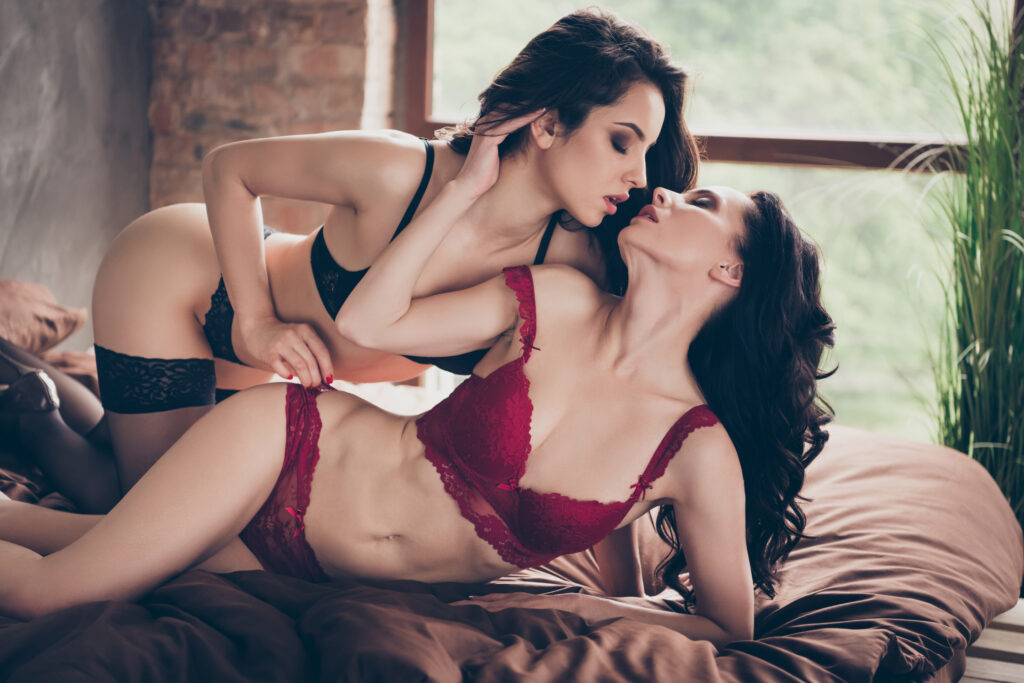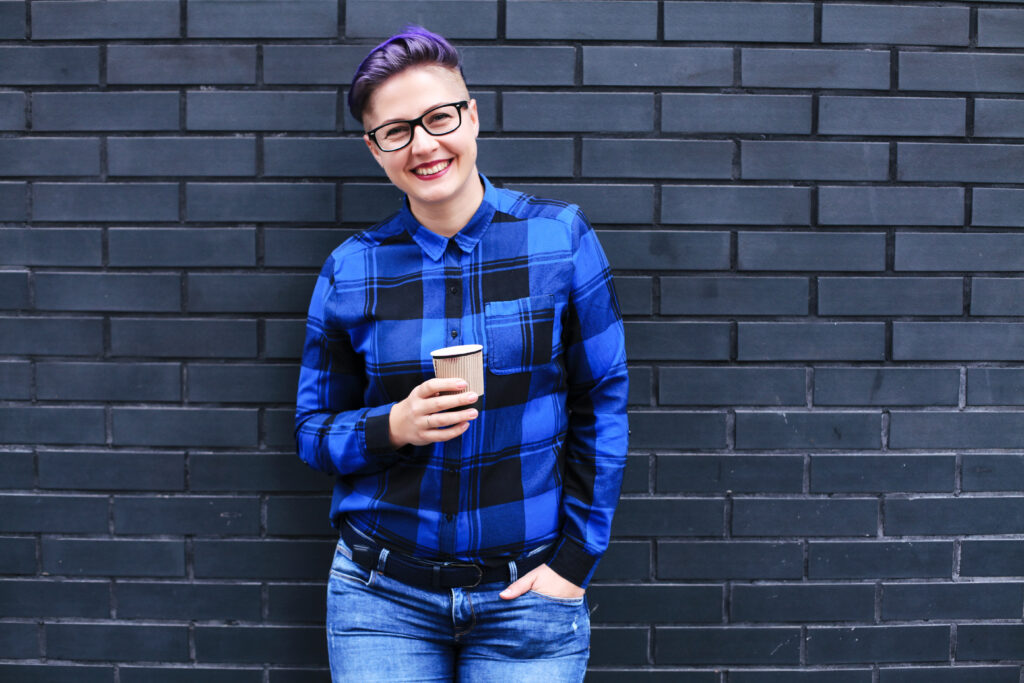Recently, I stumbled across a “lesbian” stock image where the two women looked almost identical. Were they supposed to have shared a womb or were they dating? This sent me down a stock photography rabbit hole and prompted me to see how misogynistic and heteronormative stock photography can be.
As it turns out, mainstream stock photography businesses are home to many harmful representations of womanhood and queerness. A shock, I know.
I saw biases towards women and queer folks in action. I’ve collected three images, which serve as a window into the biases that seem rampant in stock photos.
Some aspects of stock photos are puzzling. Why is lesbian sex depicted between two people who could be mistaken for twins at first glance? Why do photos of non-binary people almost exclusively represent androgyny?
Lesbian sisters

White lesbian couple wearing matching sunglasses. Picture: Rawpixel.com/Shutterstock.
The women in this photo embrace in such a way that could be read as romantic, but is casual enough that a person could see them as sisters or best gal pals. Their sunglasses, expressions of shared laughter, even the necklaces they both wear are small signifiers of similarity that quickly add up.
They are both thin and white, and their hair is even parted on the same side. These similarities make it easier to read their relationship as familial or platonic, as well as romantic.
There has been extensive research on the merits of the idea that people seek out romantic partners who look similar to them. There is even a word for it: ‘dopplebanger’.
It’s one thing to joke about a friend’s tendency to date partners with the same hair colour as them, but the genre of ‘lesbian sisters’ stock photography doesn’t exist in a vacuum of quirky or harmless dating stories.
This photo, and others like it, insist on relationships between women as something that can slip under the commercial radar. The most ‘universal’ relationship between women is a non-relationship, it seems.
I spoke to writer and researcher, Dr. Gemma Killen, whose research focuses on queer life, popular culture and community online. Their PhD was about queer women and popular culture, with a chapter on women in stock photography. Gemma confirms my hunch that vague depictions of relationships keeps the photo as commercially and widely useable as possible: it is “much easier” to create “generic” stock photos when intimacy is not explicitly romantic.
This reminded me of a time a man said to me (very unsolicited), “God, we’ve come a long way. Yuck, how disgusting!” after seeing a book with two boys holding hands on the cover.
My heart broke when I heard that. Clear depictions of queer relationships are still belittled or outright vilified, and this is reflected in the ‘safety’ of stock photos that supposedly depict lesbian couples.
Lesbians, definitely not sisters

White lesbian couple on a bed, original Shutterstock caption began with “Photo of dream desire naughty horny two people lesbians…” Picture: Roman Samborskyi/Shutterstock.
The only thing that differentiates these two women is the colour of their lingerie, which reminds me of how most sets of twins I knew as a kid went through a phase of wearing the same clothes, just in different colours.
There can be no illusion that the relationship between these two women is familial or platonic. However, even in a photo that explicitly caters to the male gaze, the two women look alarmingly similar.
“What’s interesting is that we don’t look at a stock photograph of a man and a woman with similar features and assume they are siblings, even though this might be the tendency for pictures of same-sex couples”, says Gemma.
There is still an instinct to point out their similarities, to code their relationship as familial or, as in this case, ‘weird’ because the women look alike. Gemma tells me that “the assumed audience for most stock photography is heterosexual, white and male.”
A 2021 study “revealed that lesbians found media portrayals mostly negative and stereotypical, in that they were hypersexualized and for the male gaze, with lesbian relationships portrayed as temporary.”
I could have reflected on how uncomfortable I felt looking at this photo, and how I felt detached from my own identity and sexuality when I saw it consumed through the male gaze. My instinct, even as a queer woman, was to interrogate the relationship presented to me based on how well I perceive it to serve the male gaze.
Women loving women, as it is shown here, is not actually about women loving women at all.
The androgyny assumption

White non-binary person against a grey wall. Picture: Kseniia Perminova/Shutterstock.
When I searched ‘non binary person’, pictures of white, androgynous people flooded my laptop screen. This reinforces the idea that body ideals in stock photography remain “rooted in white European ideals”, and reveals the biased assumption that non binary people ‘owe’ others androgyny.
Androgyny typically refers to “Identifying and/or presenting as neither distinguishably masculine nor feminine.” To be non-binary is to not identify with the binary understanding of gender as ‘man’ or ‘woman’. Some people conflate these two ways of being, and project this singular understanding of what being non-binary looks like onto non-binary people.
Representing non binary people as androgynous is not inherently bad, especially because androgyny provides many non binary people with the necessary freedom and self expression they need to authentically inhabit their bodies. It’s also “hard to signal something as complex as gender with a simple photograph that is designed as an empty signifier”, says Gemma.
The issue arises when this is the only representation, because “stock photography of non-binary people leans towards simplistic understandings of androgyny as vaguely masculine, but not threatening/aggressive”, continues Gemma.
It is limiting and disheartening when media communicates a narrow view of queerness. If you don’t fit that one idea, you can feel lost and invalid, as if there is a wrong way to be yourself.
One young a-gender person interviewed in a study about androgynous body ideals spoke about how dressing androgynously is the only way other people will recognise them as a-gender. They said, “I want any shape of body to be androgynous-enough, but I know I have to stereotypically androgynize myself in order to keep living. Having a non-normative body for me is about survival.”
After trawling through pages and pages of stock images, I saw how stock photography is simply another form of media communication that reinforces harmful norms and biases. This is not to say that every image I came across perpetuated ideals of whiteness, thinness and able-bodiedness.
But Gemma points out: “stock photography deals in a rhetoric of sameness that perpetuates a myth of ‘sameness’.” How do we combat ideas about “identity and aesthetics” in stock photography when those same ideas are flattened out into the one dimensional images we use in our articles everyday?
- Feature image is a stock photo. Roman Samborskyi/Shutterstock.
Jesse Blakers is a Global Studies graduate who studied at the University of Canberra. She's also a budding academic, with a current focus on queer representation in media. Jesse recently interned at BroadAgenda.





